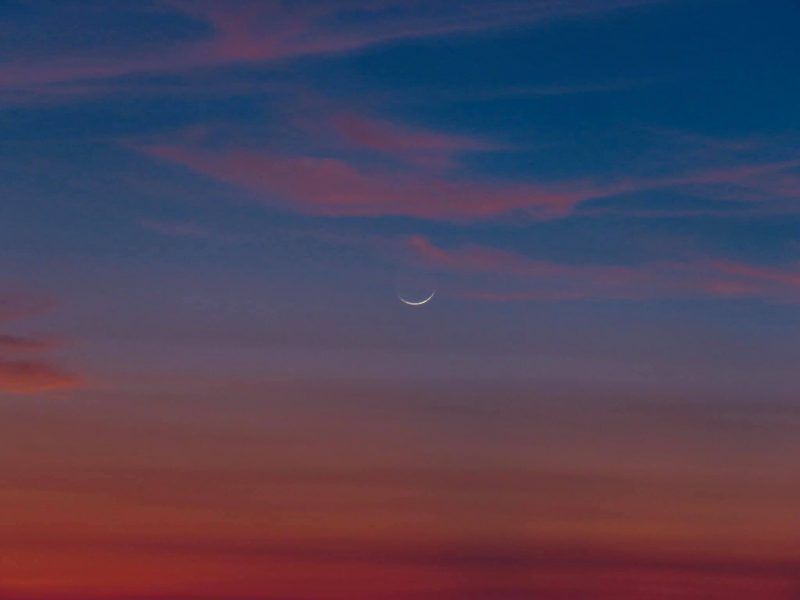
It’s fun to hunt for a young moon, a thin crescent moon visible in the west shortly after sunset. The new moon was August 19, 2020 – early in the day – at 2:42 UTC. Thus we expect many people around the world to catch the whisker-thin waxing crescent after sunset August 20. If you miss the slender young moon at dusk on August 20, try again on August 21, 22 and 23.
To see a young moon, you’ll want an unobstructed horizon in the direction of sunset. Find a hill or balcony to stand on, enabling you to peek just a little farther over your horizon. Binoculars come in handy, too, especially around August 20, when the bright evening twilight will be competing with the tiny, ghostly lunar crescent.
Although the star Spica, brightest light in the constellation Virgo the Maiden, serves as a prime example of a first-magnitude star, it might be hard to see this star in the glow of evening dusk (especially from northerly latitudes). If you can’t see it, binoculars will help.

View larger. | Jenney Disimon caught the young moon after sunset in August 2019, from Sabah, North Borneo. Thank you, Jenney!
As a general rule, it’s difficult to spot a crescent that’s less than 24 hours old (24 hours after new moon). Everywhere around the world, at sunset August 20, the moon will be over one day old. Even so, from much of the world, the slim crescent will follow the sun beneath the horizon before nightfall.
Want to know when the moon sets in your sky? Click on this Sunset Sunset Calendar, remembering to check the moonrise/moonset box. The time for sunset and moonset presumes a level horizon.
Day by day, watch the illumined portion of the lunar crescent grow, and for the moon to stay out longer after sundown. For a special treat, check out the earthshine softly illuminating the dark side of the moon with either the unaided eye or binoculars.
Bottom line: Will you catch the young moon in the west after sunset on August 20, 2020? Maybe. It’ll be easier to see on August 21, 22 and 23.
from EarthSky https://ift.tt/34jJxiW

It’s fun to hunt for a young moon, a thin crescent moon visible in the west shortly after sunset. The new moon was August 19, 2020 – early in the day – at 2:42 UTC. Thus we expect many people around the world to catch the whisker-thin waxing crescent after sunset August 20. If you miss the slender young moon at dusk on August 20, try again on August 21, 22 and 23.
To see a young moon, you’ll want an unobstructed horizon in the direction of sunset. Find a hill or balcony to stand on, enabling you to peek just a little farther over your horizon. Binoculars come in handy, too, especially around August 20, when the bright evening twilight will be competing with the tiny, ghostly lunar crescent.
Although the star Spica, brightest light in the constellation Virgo the Maiden, serves as a prime example of a first-magnitude star, it might be hard to see this star in the glow of evening dusk (especially from northerly latitudes). If you can’t see it, binoculars will help.

View larger. | Jenney Disimon caught the young moon after sunset in August 2019, from Sabah, North Borneo. Thank you, Jenney!
As a general rule, it’s difficult to spot a crescent that’s less than 24 hours old (24 hours after new moon). Everywhere around the world, at sunset August 20, the moon will be over one day old. Even so, from much of the world, the slim crescent will follow the sun beneath the horizon before nightfall.
Want to know when the moon sets in your sky? Click on this Sunset Sunset Calendar, remembering to check the moonrise/moonset box. The time for sunset and moonset presumes a level horizon.
Day by day, watch the illumined portion of the lunar crescent grow, and for the moon to stay out longer after sundown. For a special treat, check out the earthshine softly illuminating the dark side of the moon with either the unaided eye or binoculars.
Bottom line: Will you catch the young moon in the west after sunset on August 20, 2020? Maybe. It’ll be easier to see on August 21, 22 and 23.
from EarthSky https://ift.tt/34jJxiW

Aucun commentaire:
Enregistrer un commentaire